
Publius Vergilius Maro
Virgil Reading the Aeneid to Augustus

Publius Vergilius Maro (October 15, 70 BCE - September 21, 19 BCE) was a classical Roman poet, best known for three major works-the Eclogues (or Bucolics), the Georgics, and the Aeneid - although several minor poems are also attributed to him.
The son of a farmer, Virgil came to be regarded as one of Rome's greatest poets. His Aeneid can be considered a national epic of Rome and has been extremely popular from its publication to the present day.
Virgil's biographical tradition is thought to depend on a lost biography by Varius, Virgil's editor, which was incorporated into the biography by Suetonius and the commentaries of Servius and Donatus, the two great commentators on Virgil's poetry. Although the commentaries no doubt record much factual information about Virgil, some of their evidence can be shown to rely on inferences made from his poetry and allegorizing; thus, Virgil's biographical tradition remains problematic. The tradition says that Virgil was born in the village of Andes, near Mantua in Cisalpine Gaul. Scholars suggest Etruscan, Umbrian or even Celtic descent by examining the linguistic or ethnic markers of the region. Analysis of his name has led to beliefs that he descended from earlier Roman colonists. Modern speculation ultimately is not supported by narrative evidence either from his own writings or his later biographers. Etymological fancy has noted that his cognomen Maro shares its letters anagrammatically with the twin themes of his epic: Amor (love) and Roma (Rome). Macrobius says that Virgil's father was of a humble background; however, scholars generally believe that Virgil was from an equestrian landowning family which could afford to give him an education.
According to the commentators, Virgil received his first education when he was five years old and he later went to Cremona, Milan, and finally Rome to study rhetoric, medicine, and astronomy, which he soon abandoned for philosophy. From Virgil's admiring references to the neoteric writers Pollio and Cinna, it has been inferred that he was, for a time, associated with Catullus' neoteric circle. However schoolmates considered Virgil extremely shy and reserved, according to Servius, and he was nicknamed "Parthenias" or "maiden" because of his social aloofness. Virgil seems to have suffered bad health throughout his life and in some ways lived the life of an invalid. According to the "Catalepton", while in the Epicurean school of Spiro the Epicurean at Naples, he began to write poetry. A group of small works attributed to the youthful Virgil by the commentators survive collected under the title Appendix Vergiliana, but are largely considered spurious by scholars. One, the Catalepton, consists of fourteen short poems, some of which may be Virgil's, and another, a short narrative poem titled the Culex ("The Gnat"), was attributed to Virgil as early as the 1st century CE.
Virgil and Two Muses
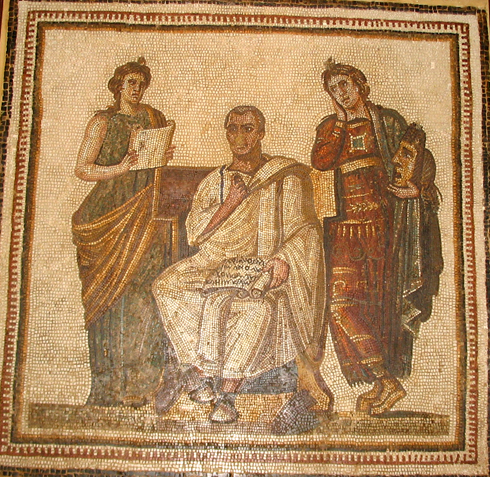
A mosaic of Virgil and Two Muses. The mosaic, which dates from the 3rd Century A.D.,
was discovered in the Hadrumetum in Sousse, Tunisia and is now on display in the Bardo
Museum in Tunis, Tunisia.
Appendix Vergiliana
The Appendix Vergiliana is a collection of poems traditionally ascribed as Juvenilia of Virgil, although it is likely that all the pieces are in fact spurious. Many were considered works of Virgil in antiquity, but it seems that they comprise a diverse collection of minor poems by various authors from the first century CE.
Scholars are almost unanimous in considering the works of the Appendix spurious primarily on grounds of style, metrics, and vocabulary. The collection as it is was probably formed in Late Antiquity, although ancient authors considered the Culex to be a youthful work of Virgil's and the Ciris is ascribed to Virgil as early as Donatus' Vita Quintilian quotes Catalepton as the work of Virgil. The Elegiae in Maecenatem cannot possibly be by Virgil, as Maecenas died eleven years after Virgil in 8 BCE. The poems are all probably by different authors, except for the Lydia and Dirae which may have a common author, and have been given various, nebulous dates within the first century CE. The Culex and the Ciris are thought to have been composed under the emperor Tiberius. Some of the poems may be attempts to pass works off under Virgil's name as pseudepigraphia, such as the Catalepton, while others seem to be independent works that were subsumed into the collection like the Ciris which is influenced more by the late Republican neoterics than Virgil.
The Naiskos Crater from Berlin showing Scenes of the Underworld
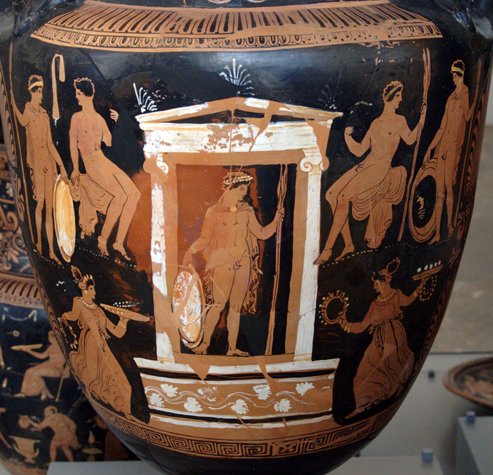
Culex ("The Gnat")
This is a pastoral epyllion in 414 hexameters which evokes the world of Theocritus and employs epic conventions for comic effect in a parody. The poem opens with an address to the Young Octavian, a promise of more poems, an Invocation of Apollo, and a Prayer for Octavian's Success. The poet has a priamel in which he rejects the Battle of the Gods and Giants and historical epic. It is noon, and a poor but happy shepherd, who lacks the refinements of classical luxury, is tending his flocks when he sees a grove of trees, a locus amoenus, and lies down to rest. The mythical metamorphoses of the trees in the grove are described. As he sleeps, a snake approaches him and is ready to bite when a gnat lands on his eyes. Reflexively killing the gnat he awakes, sees the snake and kills it. That night, the gnat appears to the shepherd in a dream, laments its undeserved fate, and gives a long description of the underworld and the souls of the dead mythological heroes there, allowing it to digress. The gnat especially focuses on the story of Eurydice and the Trojan War. The gnat goes on to describe famous Roman heroes and then his audience before Minos to decide his fate. When he awakes, the shepherd constructs a heroon to the gnat in the grove and the poet has a flower-catalogue. The shepherd inscribes it with the inscription "Little gnat, to you deservedly the guard of the flock repays his funeral duty for your gift of life." The Culex cannot be one of Virgil's juvenalia because it alludes to the full body of his work; thus, it is usually dated to sometime during the reign of Tiberius. The poem has been variously interpreted as a charming epyllion or as an elaborate allegory in which the shepherd symbolizes Augustus and the gnat Maecenas.
Ciris ("The Sea-Bird")
The Ciris is an Epyllion in 541 hexameters describing the myth of Nisus, the King of Megara and his Daughter Scylla. The epyllion was a popular style of composition which seems to have developed in the Hellenistic Age; surviving examples can be found in Theocritus and Catullus. The poet begins his hundred line prologue by invoking the Muses and Sophia, despite the fact that he is an Epicurean, and describes his poem as a gift to Messalla like the robe given to Minerva in the Panathenaia. The poet differentiates the Scylla of his poem from the sea-monster Scylla and describes the monster's birth and metamorphosis. He starts by describing Minos' siege of Megara and the lock of purple hair on the head of Nisus which protected the city. While playing ball, Scylla is shot by Cupid and falls madly in love with Minos. As a prize for Minos, she tries to cut the lock of her father, but her nurse, Carme, asks Scylla why she is upset. After Scylla tells her she is in love with Minos, Carme says that Minos earlier had killed her daughter Britomartis and convinces Scylla to go to bed. In the morning, Scylla tries to talk Nisus into making peace with Minos, and the nurse brews a magical potion, but nothing works and Scylla cuts off the lock. The city falls and Scylla, lamenting Minos' refusal to marry her, is taken prisoner on the Cretan ships which sail around Attica. The poet describes her metamorphosis in detail; by the pitying Amphitrite she is transformed into the ciris bird, supposedly from the Greek keirein ("cut"). Jupiter transforms Nisus into a sea-eagle, which pursues the ciris like Scorpio pursues Orion. Based on composition, the poem must be placed after Ovid and before the second century. A Tiberian date seems likely for its composition.
Copa ("The Barmaid")
This poem in 38 elegiac couplets describes the song of the barmaid Syrisca. She describes a lush, pastoral setting and a picnic laid out in the grass and invites an unnamed man to spend time with her, stop thinking about the future, and live for the present.
Moretum ("The Pesto")
The Moretum in 124 hexameter lines describes the preparation by the poor farmer Simylus of a meal. The poem is in the tradition of Hellenistic Poetry about the poor and their diet and has a precedent in Callimachus' Hecale and poems that describe theoxeny. Waking before dawn, he starts the fire, grinds grain as he sings and talks to his African slave Scybale, and starts baking. His garden and its products are described. Simylus fashions from garlic, cheese, and herbs the moretum a type of pesto, eats, and goes out to plow.
Dirae ("Curses")
This poem is a series of curses by a dispossessed farmer on the veteran who has usurped his land in 103 hexameter lines. The tradition of curse poetry goes back to the works of Archilochus and Hipponax. The poem may have connections to the Hellenistic Arae of Euphorion of Chalcis, but it is also very much in the pastoral tradition of Theocritus and the Eclogues. The poem opens pastorally by addressing Battarus, a friend whose farm has also been confiscated and describing the actions of the soldier called Lycurgus. First the speaker curses the plants on the farm with bareness and then asks the forests to burn before Lycurgus destroys them with his axe. He then prays to Neptune for a flood to destroy the farm and for the land to turn into a swamp. The poem ends with a farewell to his farm and his lover, Lydia.
Lydia ("Lydia")
This hexameter lament in 80 lines was connected to the Dirae because of the mention of Lydia in that poem but is probably an independent piece. It also has a pastoral setting and is in the tradition of Theocritus' amatory idylls and Latin love elegy. It begins with the poet saying he envies the countryside which Lydia inhabits and describes his pain at his separation from her. He looks to the animal world and the astronomical world with their amorous pairings and feels despair at the passing of the golden age. He describes the love of Jupiter and Juno, Venus and Adonis, and Aurora. He ends with the impossible wish to have been born in a better age.
A Painting of Priapus from the House of the Vettii in Pompeii

Priapea ("Priapus Poems")
This is a collection of three poly-metric poems with the god Priapus as the speaker. Priapea are a traditional sub-genre of Greek poetry and are primarily found in Greek epigrams. A notable piece of Priapic Poetry can be found in Theocritus and Roman examples can be found in Horace and Tibullus. The first poem in two elegiac couplets is a mock-inscription in which the god describes the setting of his statue at different seasons and his dislike of winter and fear of being made into firewood. The second poem is in iambic trimeters. Priapus addresses a passer-by, describes how he protects and nourishes the farm through the seasons, and demands respect, as his wooden phallus can double as a club. The third poem in hexameters. The Priapus statue addresses a group of boys who want to rob the farm. It describes its protection of the farm and the worship the owners give it. He ends by telling the boys to rob a neighbor's farm whose Priapus is careless.
Catalepton ("Trifles")
The Catalepton is a collection of fifteen or sixteen poems in various meters. The first elegiac poem is addressed to Tucca and describes the poet's separation from his lover. The second makes fun of a fellow writer for his obsession with Attic dialect. The third elegiac piece is a description of a successful eastern general who fell from power. Poem in elegiacs is on the poet's friendship and admiration for Octavius Musa. Poem describes a poet's giving up of rhetorical study to learn philosophy with Siro. The elegiac sixth poem criticizes Noctuinus and his father in law for some scandal with a girl. Poem in elegiacs talks about love and plays with Greek words in Latin poetry. The eighth elegiac poem addresses the farm of Siro as being dear to the poet as his Mantuan and Cremonan estates. Poem 9 is a long elegiac piece which is an encomium to Messalla describing the poet's pastoral poetry, praising Mesilla's wife, Sulpicia, and recounting his military achievements. Poem 10 is a parody of Catullus 4 and describes the career of the old muleteer Sabinus. The elegiac poem 11 is a mock lament for the drunken Octavius Musa. Poem 12 makes fun of Noctuinus for his two lovers. Poem 13 is in iambics and attacks Lucienus for his love affairs and seedy living. Poem 13a is an elegiac epitaph on an unknown scholar. Poem 14 is an elegiac prayer to Venus to help him complete the Aeneid and a promise to pay his vows to her. The final poem is an elegiac epigram for Virgil's tomb signed by Varius.
Elegiae in Maecenatem ("Elegies for Maecenas")
The Elegiae are two poems on the death of Maecenas (8 BCE) in elegiac couplets who credits it authorship to Virgil is impossible. They were formerly transmitted as one long poem. The first poem opens with the author saying he has just written a lament for a young man, perhaps Drusus who died in 9 BCE. The poet describes his first meeting with Maecenas introduced by Lollius, praises his art, and defends his wearing of loose clothes (criticized later by Seneca). Maecenas' life spent on culture rather than war is praised, as is his service at Actium; a long mythological section compares Maecenas to Bacchus and describes the labors of Hercules and his service to Omphale. The death is compared to the loss of Hesperus and Tithonus and ends with a prayer that the earth rest lightly on him. The second poem was separated and is far shorter, encompassing the dying words of Maecenas. First he wishes he had died before Drusus and then prays that he be remembered, that the Romans remain loyal to Augustus, that he have an heir, and that Augustus is deified by Venus.
The biographical tradition asserts that Virgil began the hexameter Eclogues (or Bucolics) in 42 BCE and it is thought that the collection was published around 39-38 BCE, although this is controversial. The Eclogues (from the Greek for "selections") are a group of ten poems roughly modeled on the bucolic hexameter poetry ("pastoral poetry") of the Hellenistic poet Theocritus. After his victory in the Battle of Philippi in 42 BCE, fought against the army led by the assassins of Julius Caesar, Octavian tried to pay off his veterans with land expropriated from towns in northern Italy, supposedly including, according to the tradition, an estate near Mantua belonging to Virgil. The loss of his family farm and the attempt through poetic petitions to regain his property have traditionally been seen as Virgil's motives in the composition of the Eclogues. This is now thought to be an unsupported inference from interpretations of the Eclogues. In Eclogues 1 and 9, Virgil indeed dramatizes the contrasting feelings caused by the brutality of the land expropriations through pastoral idiom, but offers no indisputable evidence of the supposed biographic incident. Readers often did and sometimes do identify the poet himself with various characters and their vicissitudes, whether gratitude by an old rustic to a new god (Eclogue 1), frustrated love by a rustic singer for a distant boy (his master's pet, Eclogue 2), or a master singer's claim to have composed several eclogues (Eclogue 5). Modern scholars largely reject such efforts to garner biographical details from fictive texts preferring instead to interpret the diverse characters and themes as representing the poet's own contrastive perceptions of contemporary life and thought.
Thematically, the ten Eclogues develop and vary pastoral tropes and play with generic expectations. 1 and 9 address the land confiscations and their effects on the Italian countryside. 2 and 3 are highly pastoral and erotic, discussing love, both homosexual (Eclogue 2) and panerotic (Eclogue 3). Eclogue 4, addressed to Asinius Pollio, the so-called 'Messianic Eclogue' uses the imagery of the Golden-Age in connection with the birth of a child (who the child is has been highly contested). 5 and 8 describe the Myth of Daphnis in a song contest, 6, the cosmic and mythological Song of Silenus, 7, a heated poetic contest, and 10 the sufferings of the contemporary elegiac poet Cornelius Gallus. Virgil is credited in the "Eclogues" with establishing Arcadia as a poetic ideal that still resonates in Western literature and visual arts and setting the stage for the development of Latin pastoral by Calpurnius Siculus, Nemesianus, and later writers.
Sometime after the publication of the Eclogues (probably before 37 BCE), Virgil became part of the Circle of Maecenas, Octavian's capable agent d'affaires who sought to counter sympathy for Antonius among the leading families by rallying Roman literary figures to Octavian's side. Virgil seems to have made connections with many of the other leading literary figures of the time, including Horace, in whose poetry he is often mentioned, and Varius Rufus, who later helped finish the Aeneid. At Maecenas' insistence (according to the tradition) Virgil spent the ensuing years (perhaps 37-29 BCE) on the longer didactic hexameter poem called the Georgics (from Greek, "On Working the Earth") which he dedicated to Maecenas. The apparent theme of the Georgics is instruction in the methods of running a farm. In handling this theme, Virgil follows in the didactic (instructive) tradition of the Greek poet Hesiod one of whose poems focuses on farming and the later Hellenistic poets. The four books of the Georgics focus respectively on raising crops and trees (1 and 2), livestock and horses (3), and beekeeping and the qualities of bees (4). Significant passages include the beloved Laus Italiae of Book 2, the prologue description of the temple in Book 3, and the description of the plague at the end of Book 3. Book 4 concludes with a long mythological narrative, in the form of an epyllion which describes vividly the discovery of beekeeping by Aristaeus and the story of Orpheus' journey to the underworld. Ancient scholars conjectured that the Aristaeus episode replaced a long section in praise of Virgil's friend, the poet Gallus, who was disgraced by Augustus and committed suicide in 26 BCE. Augustus is supposed to have ordered the section to be replaced. A major critical issue in considering the Georgics is the assessment of tone; Virgil seems to waver between optimism and pessimism, sparking a great deal of debate on the poem's intentions. With the Georgics Virgil is again credited with laying the foundations for later didactic poetry. The biographical tradition says that Virgil and Maecenas took turns reading the Georgics to Octavian upon his return from defeating Antonius and Cleopatra at the Battle of Actium in 31 BCE.
Georgics Book III, Shepherd with Flocks, Roman Virgil
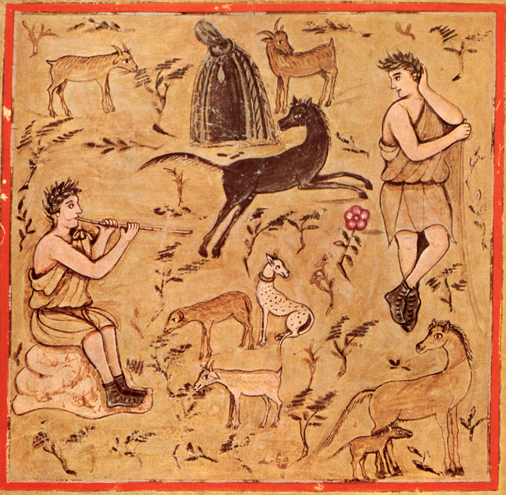
The Georgics is a poem in four books, likely published in 29 BC. It is the second major work by the Latin poet Virgil, following his Eclogues and preceding the Aeneid. It is a poem that draws on many prior sources and influenced many later authors from antiquity to the present. Scholars have often been at odds over how to read the work as a whole, and puzzled over such phrases as labor omnia vincit / improbus (1.145-146), which is not simply the platitude, "work conquers all", but "shameful work conquers all". As its name suggests (Georgica, from the Greek word georgein, 'to farm') the subject of the poem is agriculture; but far from being an example of peaceful rural poetry, it is a work characterized by tensions in both theme and purpose.
Book One
Virgil begins his poem with a summary of the four books, followed by a prayer to various agricultural deities as well as Augustus himself. It takes as its model the work on farming by Varro, but differs from it in important ways. Numerous technical passages fill out the first half of Book 1; of particular interest are lines 160-175, where Virgil describes the plow. In the succession of ages, whose model is ultimately Hesiod, the age of Jupiter and its relation to the golden age and the current age of man are crafted with deliberate tension. Of chief importance is the contribution of labor to the success or failure of mankind's endeavors, agricultural or otherwise. The book comes to one climax with the description of great storm in lines 311-50, which brings all of man's efforts to naught. After detailing various weather-signs, Virgil ends with an enumeration of the portents associated with Caesar's assassination and civil war; only Octavian offers any hope of salvation.
Book Two
Prominent themes of the second book include agriculture as man's struggle against a hostile natural world, often described in violent terms, and the Ages of Saturn and Jupiter. Like the first book, it begins with a proem addressing the divinities associated with the matters about to be discussed: viticulture, trees, and the olive. In the next hundred lines Virgil treats forest and fruit trees. Their propagation and growth are described in detail, with a contrast drawn between the methods which are natural and those which require human intervention. Three sections on grafting are of particular interest: presented as marvels of man's alteration of nature, many of the examples Virgil gives are unlikely or impossible. Also included is a catalogue of the world's trees, set forth in rapid succession, and other products of various lands. Perhaps the most famous passage of the poem, the Laudes Italiae or Praises of Italy, is introduced by way of a comparison with foreign marvels: despite all of those, no land is as praiseworthy as Italy. A point of cultural interest is a reference to Ascra in line 176, which an ancient reader would have known as the hometown of Hesiod. Next comes the care of vines, culminating in a vivid scene of their destruction by fire; then advice on when to plant vines, and therein the other famous passage of the second book, the Praises of Spring. These depict the growth and beauty that accompany spring's arrival. The poet then returns to didactic narrative with yet more on vines, emphasizing their fragility and laboriousness. A warning about animal damage provides occasion for an explanation of why goats are sacrificed to Bacchus. The olive tree is then presented in contrast to the vine: it requires little effort on the part of the farmer. The next subject, at last turning away from the vine, is other kinds of trees: those that produce fruit and those that have useful wood. Then Virgil again returns to grapevines, recalling the myth of the Battle of the Lapiths and Centaurs in a passage known as the Vituperation of Vines. The remainder of the book is devoted to extolling the simple country life over the corruptness of the city.
Book Three
The third book is chiefly and ostensibly concerned with animal husbandry. It consists of two principal parts, the first half devoted to the selection of breed stock and the breeding of horses and cattle. It concludes with a description of the furor induced in all animals by sexual desire. The second half of the book is devoted to the care and protection of sheep and goats and their byproducts. It concludes with a description of the havoc and devastation caused by a plague in Noricum. Both halves begin with a short prologue called a proem. The proems invoke Greek and Italian gods and address such issues as Virgil's intention to honor both Caesar and his patron Maecenas, as well as his lofty poetic aspirations and the difficulty of the material to follow. Many have observed the parallels between the dramatic endings of each half of this book and the irresistible power of their respective themes of love and death.
Book Four
Book four, a tonal counterpart to Book two, is divided approximately in half; the first half (1-280) is didactic and deals with the life and habits of bees, supposedly a model for human society. Bees resemble man in that they labor, are devoted to a king and give their lives for the sake of the community, but they lack the arts and love. In spite of their labor the bees perish and the entire colony dies. The restoration of the bees is accomplished by bugonia, spontaneous rebirth from the carcass of an ox. This process is described twice in the second half (281-568) and frames the Aristaeus epyllion beginning at line 315. The tone of the book changes from didactic to epic and elegiac in this epyllion which contains within it the story of Orpheus and Eurydice. Aristaeus, after losing his bees, descends to the home of his mother, the nymph Cyrene, where he is given instructions on how to restore his colonies. He must capture the seer, Proteus, and force him to reveal which divine spirit he angered and how to restore his bee colonies. After binding Proteus (who changes into many forms to no avail), Aristaeus is told by the seer that he angered the nymphs by causing the death of the nymph Eurydice, wife of Orpheus. Proteus describes the descent of Orpheus into the underworld to retrieve Eurydice, the backward look which caused her return to Tartarus, and at last Orpheus' death at the hands of the Ciconian women. Book four concludes with an eight-line sphragis or seal in which Virgil contrasts his life of poetry with that of Octavian the general.
Greek
Virgil's model for composing a didactic poem in hexameters is the archaic Greek poet Hesiod, whose poem Works and Days shares with the Georgics the themes of man's relationship to the land and the importance of hard work. The Hellenistic Poet Nicander's lost Georgics may also be an important influence. Virgil used other Greek writers as models and sources, some for technical information, including the Hellenistic poet Aratus for astronomy and meteorology, Nicander for information about snakes, the philosopher Aristotle for zoology, and Aristotle's student Theophrastus for botany, and others, such as the Hellenistic poet Callimachus for poetic and stylistic considerations. The Greek literary tradition from Homer on also serves as an important source for Virgil's use of mythological detail and digression.
Roman
Lucretius' De Rerum Natura serves as Virgil's primary Latin model in terms of genre and meter. Many passages from Virgil's poetry are indebted to Lucretius: the plague section of Book 3 takes as its model the plague of Athens that closes the De Rerum Natura. Virgil is also indebted to Ennius, who, along with Lucretius, naturalized hexameter verse in Latin. Virgil often uses language characteristic of Ennius to give his poetry an archaic quality. The intriguing idea has been put forth by one scholar that Virgil also drew on the rustic songs and speech patterns of Italy at certain points in his poem, to give portions of the work a distinct, Italian character. Virgil draws on the neoteric poets at times, and Catullus' Carmen 64 very likely had a large impact on the epyllion of Aristaeus that ends the Fourth Georgic. Virgil's extensive knowledge and skillful integration of his models is central to the success of different portions of the work and the poem as a whole.
Philosophical Context
The two predominant philosophical schools in Rome during Virgil's lifetime were Stoicism and the Epicureanism. Of these two, the Epicurean strain is predominant not only in the Georgics but also in Virgil's social and intellectual milieu. Varius Rufus, a close friend of Virgil and the man who published the Aeneid after Virgil's death, had Epicurean tastes, as did Horace and his patron Maecenas. The philosophical text which had the greatest influence upon the Georgics as a whole was Lucretius' Epicurean Epic De Rerum Natura.
Zeno of Citium
(The Founder of Stoicism)

Epicurus of Samos
(The Founder of Epicureanism)
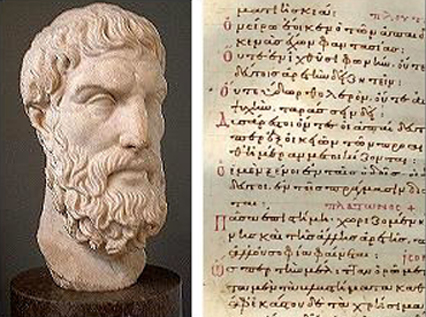
Political Context
Beginning with Caesar's assassination in 44 BC and ending with Octavian's victory over Antonius and Cleopatra at Actium in 31 BC, Rome had been engaged in a series of almost constant civil wars. After almost 15 years of political and social upheaval, Octavian, the sole surviving member of the Second Triumvirate, became firmly established as the new leader of the Roman World. Under Octavian, Rome enjoyed a long period of relative peace and prosperity. However, Octavian's victory at Actium also sounded the Death Knell of the Republic. With Octavian as the sole ruler of the Roman world, the Roman Empire was born.
It was during this period, and against this backdrop of civil war, that Virgil composed the Georgics. While not containing any overtly political passages, politics are not absent from the Georgics. Not only is Octavian addressed in the poem both directly and indirectly, but the poem also contains several passages that include references and images that could be interpreted as political, such as the description of the plague in Book 3 and Virgil's famous description of bee society in Book 4. It is impossible to know whether or not these references and images were intended to be seen as political in nature, but it would not be inconceivable that Virgil was in some way influenced by the years of civil war. Whether they were intentional or not, if we believe Suetonius, these references did not seem to trouble Octavian, to whom Virgil is said to have recited the Georgics in 29 BC. We can be fairly sure that if Octavian had been displeased by these references, they would not have been included in the published poem.
The Second Triumvirate

Roman Aureus bearing the portraits of Mark Antony (left) and Octavian (right), issued in 41 BC to celebrate the establishment of the Second Triumvirate by Octavian, Antony and Marcus Lepidus in 43 BC. Both sides bear the inscription "III VIR R P C", meaning "One of Three Men for the Regulation of the Republic".
Octavian

Laudes Galli
A comment by the Virgilian commentator Servius, that the middle to the end of the Fourth Georgic contained a large series of praises for Cornelius Gallus (Laudes Galli means "Praises of Gallus" in Latin), has spurred much scholarly debate. Servius tells us that after Gallus had fallen out of favor, Virgil replaced the praises of Gallus with the Orpheus Episode. Those supporting Servius see the Orpheus episode as an unpolished, weak episode, and point out that it is unlike anything else in the Georgics in that it radically departs from the "didactic" mode that we see throughout, rendering it an illogical, awkward insertion. Indeed, the features of the episode are unique; it is an epyllion that engages mythological material. The episode does not further the narrative and has no immediately apparent relevance to Virgil's topic. The difficult, open-ended conclusion seems to confirm this interpretation.
In a highly influential article Anderson debunked this view, and it is now generally believed that there were not Laudes Galli and that the Orpheus Episode is original. Generally, arguments against the view above question Servius' reliability, citing the possibility that he confused the end of the Georgics with the end of the Eclogues, which does make mention of Gallus. Further, they question its validity based on chronological evidence: the Georgics would have been finished a number of years before the disgrace and suicide of Gallus, and so one would expect more evidence of an alternative version of the end of the poem - or at least more sources mentioning it. Instead, the Orpheus Episode is here understood as an integral part of the poem that articulates or encapsulates its ethos by reinforcing many ideas or reintroducing and problematizing tensions voiced throughout the text. The range of scholarship and interpretations offered is vast, and the arguments range from optimistic or pessimistic readings of the poem to notions of labor, Epicureanism, and the relationship between man and nature.
The Aeneid
The Aeneid is a Latin epic poem written by Virgil in the late 1st century BC (29-19 BC) that tells the legendary story of Aeneas, a Trojan who traveled to Italy, where he became the ancestor of the Romans. It is composed of roughly 10,000 lines in dactylic hexameter. The first six of the poem's twelve books tell the story of Aeneas' wanderings from Troy to Italy, and the poem's second half tells of the Trojans' ultimately victorious war upon the Latins, under whose name Aeneas and his Trojan followers are destined to be known.
The hero Aeneas was already known to Greco-Roman Legend and Myth, having been a character in the Iliad; Virgil took the disconnected tales of Aeneas' wanderings, his vague association with the foundation of Rome and a personage of no fixed characteristics other than a scrupulous piety, and fashioned this into a compelling founding myth or nationalist epic that at once tied Rome to the legends of Troy, glorified Traditional Roman Virtues and Legitimized the Julio-Claudian Dynasty as descendants of the founders, heroes and gods of Rome and Troy.
Aeneas Flees Burning Troy
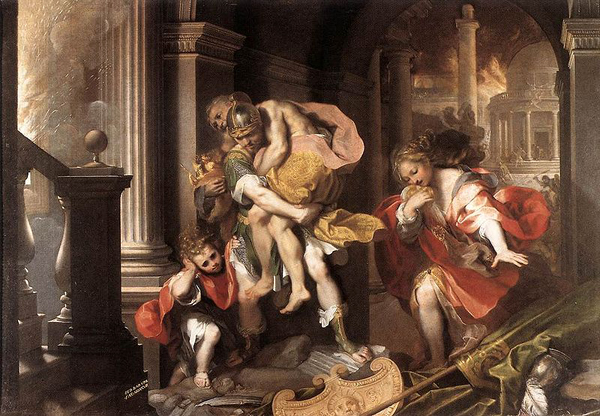
The Aeneid can be divided into two halves based on the disparate subject matter of Books 1-6 (Aeneas' journey to Latium in Italy) and Books 7-12 (The War in Latium). These two halves are commonly regarded as reflecting Virgil's ambition to rival Homer by treating both the Odyssey's wandering theme and the Iliad's warfare themes. This is, however, a rough correspondence, the limitations of which should be borne in mind.
Map of Aeneas' Journey
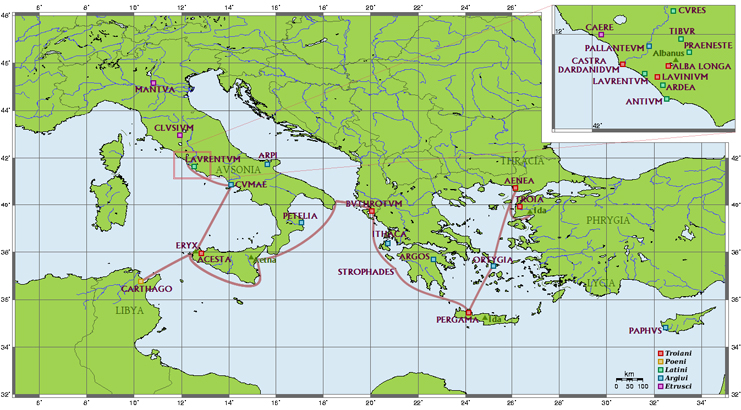
Journey to Italy (Books I - VI)
Virgil begins his poem with a statement of his theme (Arma virumque cano, "I sing of arms and of a man") and an invocation to the Muse, falling some ten lines after the poem's beginning: (Musa, mihi causas memora, "O Muse, recount to me the causes"). He then explains the reason for the principal conflict in the story: the resentment held by the goddess Juno against the Trojan people. This is consistent with her role throughout the Homeric epics.
Also in the manner of Homer, the story proper begins in medias res, with the Trojan fleet in the eastern Mediterranean, heading in the direction of Italy. The fleet, led by Aeneas, is on a voyage to find a second home. It has been foretold that in Italy, he will give rise to a race both noble and courageous, a race which will become known to all nations. Juno is wrathful, because she had not been chosen in the Judgment of Paris against Aeneas's mother Venus, and because her favorite city, Carthage, will be destroyed by Aeneas' descendants. Also, Ganymede, a Trojan prince, was chosen to be the god's cup bearer-replacing Juno's daughter Hebe. Juno proceeds to Aeolus, King of the Winds, and asks that he release the winds to stir up a storm in exchange for a bribe (Deiopea, the loveliest of all the sea nymphs, as a wife). He agrees, and the storm devastates the fleet. Neptune takes notice: although he himself is no friend of the Trojans, he is infuriated by Juno's intrusion into his domain, and stills the winds and calms the waters. The fleet takes shelter on the coast of Africa. There, Aeneas's mother, Venus, in the form of a hunting woman very similar to the goddess Diana, encourages him and tells him the history of the city. Eventually, Aeneas ventures in, and in the temple of Juno, seeks and gains the favor of Dido, Queen of Carthage, the city which has only recently been founded by refugees from Tyre and which will later become one of Rome's greatest enemies.
Aeneas and Dido
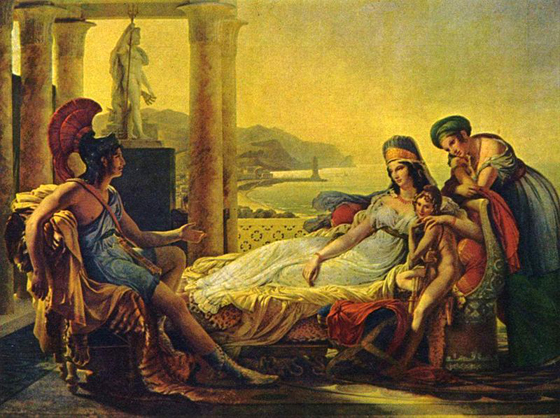
Aeneas Relates the Events of the Trojan War to Dido
At a banquet given in the honor of the Trojans, Aeneas recounts sadly the events which occasioned the Trojans' fortuitous arrival. He begins the tale shortly after the events described in the Iliad. Crafty Ulysses devised a way for Greek warriors to gain entry into Troy by hiding in a large wooden horse. The Greeks pretended to sail away, leaving a man, Sinon, to tell the Trojans that the horse was an offering and that if it were taken into the city, the Trojans would be able to conquer Greece. The Trojan priest Laocoön, who had seen through the Greek plot and urged the horse's destruction, hurled his spear at the wooden horse. Just after, in what would be seen by the Trojans as punishment from the gods, Laocoön was suddenly grabbed and eaten, along with his two sons, by two giant sea snakes. So the Trojans brought the horse inside the fortified walls, and after nightfall the armed Greeks emerged and began to slaughter the city's inhabitants. Aeneas woke up and saw with horror what was happening to his beloved city. At first he tried to fight against the enemy, but soon he lost his comrades and was left alone to fend off tens of Greeks. Hector, the fallen Trojan Prince, tells him to flee with his family. Aeneas tells of his escape with his son Ascanius and father Anchises, his wife Creusa having been separated from the others and subsequently killed in the general catastrophe. He tells of how, rallying the other survivors, he built a fleet of ships and made landfall at various locations in the Mediterranean: Thrace, where they find the last remains of a fellow Trojan, Polydorus; Strophades, where they are cursed by the harpy Celaeno; Crete, which they believe to be the land where they are to build their city (but they are set straight by Apollo); and Buthrotum. This last had been built in an attempt to replicate Troy. In Buthrotum, Aeneas met Andromache, the widow of Hector. She still laments for the loss of her valiant husband and beloved child. There, too, Aeneas saw and met Helenus, one of Priam's sons, who had the gift of prophecy. Through him, Aeneas learned the destiny laid out for him: he was divinely advised to seek out the land of Italy (also known as Ausonia or Hesperia), where his descendants would not only prosper, but in time rule the entire known world. In addition, Helenus also bade him go to the Sibyl in Cumae. Heading out into the open sea, Aeneas left Buthrotum, rounding Italy's cape and making his way towards Sicily (Trinacria). There, they are caught in the Whirlpool of Charybdis and driven out to sea. Soon they come ashore at the land of the Cyclops. There they meet a Greek, Achaemenides, one of Odysseus' men, who had been left behind when his comrades escaped the cave of Polyphemus. They take Achaemenides onboard and narrowly escape Polyphemus. Shortly after these events, Anchises dies peacefully of old age.
Laocoon and his Sons
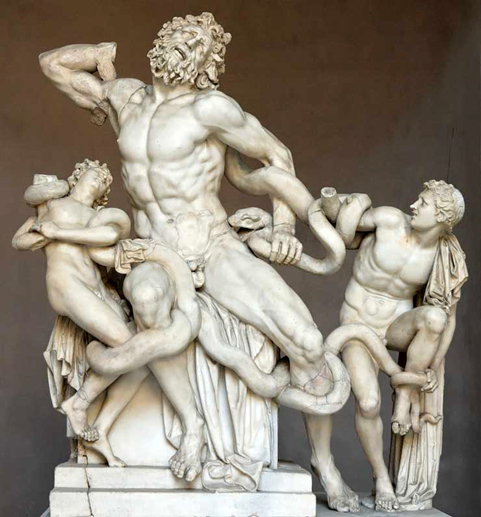
"Beware of the Danaous (Greeks), Bearing Gifts"
Apollo and the Cumaean Sibyl
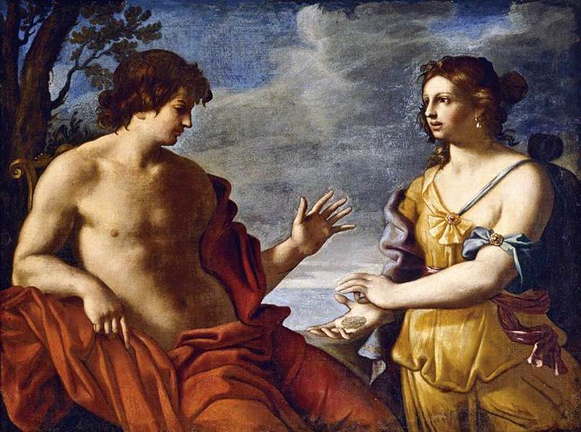
Meanwhile, Venus has her own plans. She goes to her son, Aeneas' half-brother Cupid, and tells him to disguise himself as Ascanius. Disguised as such, he goes to Dido, and offers the gifts expected from a guest. With her motherly love revived in the sight of the boy, her heart is pierced and she falls in love with the boy and his father. During the banquet, Dido realizes that she has fallen madly in love with Aeneas, although she had previously sworn fidelity to the soul of her late husband, Sychaeus, who had been murdered by her greedy brother Pygmalion. Juno seizes upon this opportunity to make a deal with Venus, Aeneas' mother, with the intention of distracting him from his destiny of founding a city in Italy. Aeneas is inclined to return Dido's love, and during a hunting expedition, a storm drives them into a cave in which Aeneas and Dido presumably have sex, an event that Dido takes to indicate a marriage between them. But when Jupiter sends Mercury to remind Aeneas of his duty, he has no choice but to part. Her heart broken, Dido commits suicide by stabbing herself upon a pyre with Aeneas' sword. Before dying, she predicts eternal strife between Aeneas's people and hers; "rise up from my bones, avenging spirit" is an obvious invocation to Hannibal. Looking back from the deck of his ship, Aeneas sees Dido's funeral pyre's smoke and knows its meaning only too clearly. However, destiny calls and the Trojan fleet and it sails on to Italy.
Aeneas's father Anchises having been hastily interred on Sicily during the fleet's previous landfall there, the Trojans returned to the island to hold funeral games in his honor. Eventually, the fleet lands on the mainland of Italy and the quest enters a new phase. Aeneas, with the guidance of the Cumaean Sibyl, descends into the underworld through an opening at Cumae; there he speaks with the spirit of his father and has a prophetic vision of the destiny of Rome. Upon returning to the land of the living, Aeneas leads the Trojans to settle in the land of Latium, where he courts Lavinia, the daughter of King Latinus.
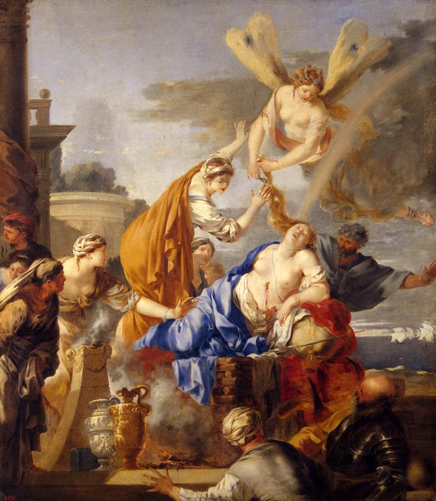
The story depicted in the painting is from Virgil's Aeneid. The lovers, Dido and Aeneas, passed a whole winter in each other's company, until Aeneas was suddenly visited by Mercury, the messenger of the gods, with sharp orders from Jupiter to be on his way. He took his leave amid scenes of passionate pleading, vituperation and tears. When Aeneas had departed Dido built a funeral pyre in the palace and slew herself on it, using her lovers sword.
Quoted From: The Web Gallery of Art
Aeneas Lands in Latium
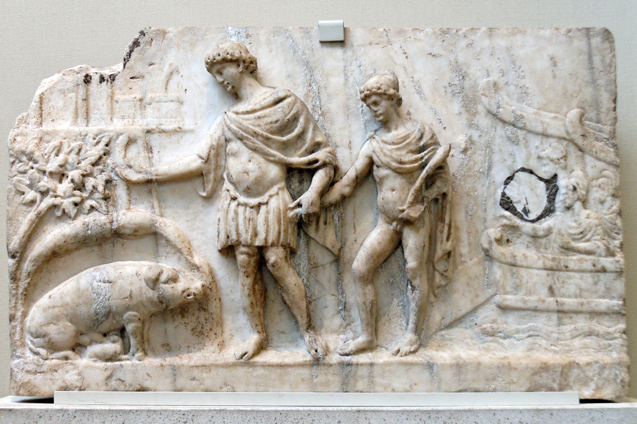
War in Italy (Books VII - XII)
Although Aeneas would have wished to avoid it, war eventually breaks out. Juno is heavily involved in causing this war - she convinces the Queen of Latium to demand that Lavinia be married to Turnus, the king of a local people, the Rutulians. Juno continues to stir up trouble, even summoning the Fury Alecto to ensure that a war takes place.
Seeing the masses of Italians that Turnus has brought against him, Aeneas seeks help from the Etruscans, enemies of Turnus. He meets King Evander from Arcadia, whose son Pallas agrees to lead troops against the other Italians. Meanwhile, the Trojan camp is being attacked, and a midnight raid leads to the deaths of Nisus and his companion Euryalus, in one of the most emotional passages in the book. The gates, however, are defended until Aeneas returns with his Etruscan and Arcadian reinforcements.
In the battling that follows, many heroes are killed, notably Pallas, who is killed by Turnus, and Mezentius, Turnus' close associate who inadvertently allows his son to be killed while he himself flees; he reproaches himself and faces Aeneas in single combat - an honorable but essentially futile pursuit. Another notable hero, Camilla, a sort of Amazon character, fights bravely but is eventually killed. Camilla had been a virgin devoted to Diana and to her nation; the man who killed her was struck dead by Diana's sentinel Opis after doing so, even though he tried to escape.
After this, single combat is proposed between Aeneas and Turnus, but Aeneas was so obviously superior that the Italians, urged on by Turnus' divine sister, Juturna, break the truce. Aeneas is injured, but returns to the battle shortly afterwards. Turnus and Aeneas dominate the battle on opposite wings, but when Aeneas makes a daring attack at the city of Latium itself (causing the queen of Latium to hang herself in despair), he forces Turnus into single combat once more. In a dramatic scene, Turnus' strength deserts him as he tries to hurl a rock, and he is struck by Aeneas' spear in the leg. As Turnus is begging on his knees for his life, the poem ends with Aeneas killing him in rage when he sees that Turnus is wearing the belt of his friend Pallas as a trophy.
Aeneas and Turnus
(In the final Combat of the War)
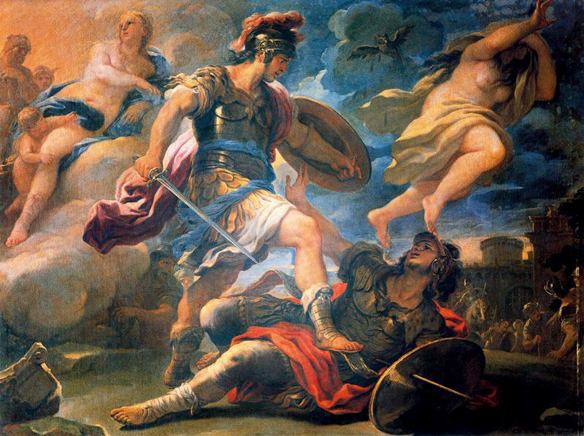
History
The Aeneid was written in a time of major political and social change in Rome, with the Fall of the Republic and the Final War of the Roman Republic having torn through society and many Romans' faith in the "Greatness of Rome" severely faltering. However, the new emperor, Augustus Caesar, began to institute a new era of prosperity and peace, specifically through the re-introduction of traditional Roman moral values. The Aeneid was seen as reflecting this aim, by depicting the heroic Aeneas as a man devoted and loyal to his country and its prominence, rather than personal gains, and going off on a journey for the betterment of Rome. In addition, the Aeneid attempted to legitimize the rule of Julius Caesar (and by extension, of his adopted son Augustus and his heirs) by renaming Aeneas' son, Ascanius (called Iulus from Ilium, meaning Troy), Iulus and offering him as an ancestor of the gens Julia, the family of Julius Caesar, and many other great imperial descendants as part of the prophecy given to him in the Underworld.
Some legends state that Virgil, fearing that he would die before he had properly revised the poem, gave instructions to friends (including the current emperor, Augustus) that the Aeneid should be burned upon his death, owing to its unfinished state and because he had come to dislike one of the sequences in Book VIII, in which Venus and Vulcan have sexual intercourse, for its nonconformity to Roman moral virtues. The friends did not comply with Virgil's wishes and Augustus himself ordered that they be disregarded. After minor modifications, the Aeneid was published.
Flight from Troy
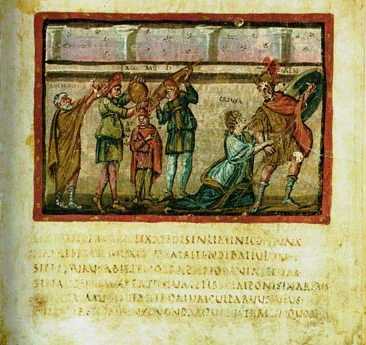
Themes
Nearly the entirety of the Aeneid is devoted to the Theme of Conflict. The primary conflict is that of Aeneas, as guided by gods such as Jupiter, Apollo and Venus, Aeneas' mother. Aeneas is representative of pietas (a self-less sense of duty), against Turnus, who is guided by Juno, representing unbridled furor (mindless passion and fury). Furor is also personified in the character Dido, however although her furor conflicts with Aeneas' pietas, she herself is not pitted against Aeneas. Other conflicts within the Aeneid include fate versus action, male versus female, Rome versus Carthage, Aeneas as Odysseus in Books I - VI versus Aeneas as Achilles in Books VII - VII, calm weather versus storms, and the Gate of Horn versus the Ivory Gate of Book VI.
Pietas, possibly the key quality of any 'honorable' Roman, consisted of a series of duties: duty towards the gods (hence the English word piety), duty towards one's homeland, duty towards one's followers and duty to one's family - especially one's father. Therefore, a further theme of the poem explores the strong relationship between fathers and sons. The bonds between Aeneas and Ascanius, Aeneas and Anchises, Evander and Pallas, Mezentius and Lausus are all worthy of note. This theme reflects Augustan moral reforms and was perhaps intended to set an example for Roman youth.
The major moral of the Aeneid is acceptance of the workings of the gods as fate through the use of pietas or piety. In composing the character of Aeneas, Virgil alludes to Augustus, suggesting that the gods work their ways through humans, using Aeneas to found Rome and Augustus to lead it, and that one must accept one's fate.
Allegory
The most debated theories with regard to the Aeneid involve whether Virgil meant to convey a so-called "hidden message" or allegory within the poem. The first section in question is:
There are two gates of Sleep, one said to be of horn, whereby the true shades pass with ease, the other all white ivory agleam without a flaw, and yet false dreams are sent through this one by the ghost to the upper world. Anchises now, his last instructions given, took son and Sibyl and let them go by the Ivory Gate.
~ Book VI
Aeneas's exiting of the underworld through the gate of false dreams has been variously interpreted: One suggestion is that the passage simply refers to the time of day at which Aeneas returned to the world of the living; another is that it implies that all of Aeneas's actions in the remainder of the poem are somehow "false". In an extension of the latter interpretation, it has been suggested that Virgil is conveying that the history of the world since the foundation of Rome is but a lie. Other scholars claim that Virgil is establishing that the theological implications of the preceding scene (i.e. an apparent system of reincarnation) are not to be taken as literal.
The second section in question is:
Then to his glance appeared the accursed sword belt surmounting Turnus' shoulder, shining with its familiar studs - the strap Young Pallas wore when Turnus wounded him and left him dead upon the field; now Turnus bore that enemy token on his shoulder - enemy still. For when the sight came home to him, Aeneas raged at the relic of his anguish worn by this man as trophy. Blazing up and terrible in his anger, he called out:
"You in your plunder, torn from one of mine, shall I be robbed of you? This wound will come from Pallas: Pallas makes this offering, and from your criminal blood exacts his due." He sank his blade in fury in Turnus' chest …
~ Book XII
Virgil's Death and Editing of the Aeneid
According to the tradition, Virgil traveled to Greece around 19 BCE in order to revise the Aeneid. After meeting Augustus in Athens and deciding to return home, Virgil caught a fever while visiting a town near Megara. After crossing to Italy by ship, weakened with disease, Virgil died in Brundisium harbor on September 21, 19 BCE. Augustus ordered Virgil's literary executors, Lucius Varius Rufus and Plotius Tucca, to disregard Virgil's own wish that the poem be burned, instead ordering it published with as few editorial changes as possible. As a result, the text of the Aeneid that exists may contain faults which Virgil was planning to correct before publication. However, the only obvious imperfections are a few lines of verse that are metrically unfinished.
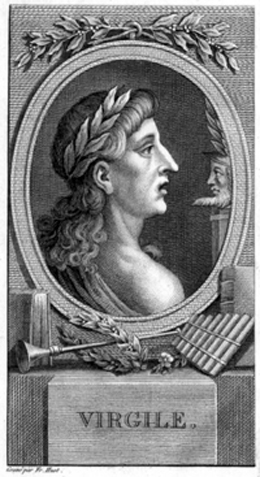
The Aeneid
Translated by John Dryden
The Aeneid Summaries, Books I - XII
Quoted From: Virgil - Wikipedia
Quoted From: Appendix Vergiliana - Wikipedia
Quoted From: Georgics - Wikipedia
Quoted From: Aeneid - Wikipedia
Return to Persona Historiae
Return to Pagina Artis
Return to Bruce and Bobbie's Main Page.